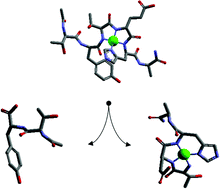In order to reveal more information about the toxicity caused by metals and furthermore their influence to the physiological metabolism of the cell, the hexapeptide model Ac-ThrTyrThrGluHisAla-am representing the C-terminal 71–76 fragment of histone H4 which lies into the nucleosome core, was synthesized. A combined pH-metric and spectroscopic UV-VIS, EPR, CD and NMR study of Ni(II) and Cu(II) binding to the blocked hexapeptide, revealed the formation of octahedral complexes involving imidazole nitrogen of histidine, at pH 5 and pH 7 for Cu(II) and Ni(II) ions respectively. In basic solutions a major square-planar 4 N Ni(II)-complex, adopting a {NIm, 3N−} coordination mode, was formed. In the case of Cu(II) ions, a 3 N complex, involving the imidazole nitrogen of histidine and two deprotonated amide nitrogens of the backbone of the peptide, at pH 7 and a series of 4 N complexes starting at pH 6.5, were suggested. In addition Ni(II)-mediated hydrolysis of the peptide bond-Tyr-Thr was evident following our experimental data.

You have access to this article
 Please wait while we load your content...
Something went wrong. Try again?
Please wait while we load your content...
Something went wrong. Try again?


 Please wait while we load your content...
Please wait while we load your content...